- Much maligned and undervalued over the centuries, temperate peatlands have seen a lot damage in that time — drained for agriculture, planted with trees, mined for horticulture and fuel. But in an age of escalating climate change, people are now turning to restoration.
- As potent carbon sequesters, peatlands have only recently been given new attention, with active restoration taking place in many nations around the world. This story focuses on groundbreaking temperate peatland restoration efforts in the U.S. Southeast, Scotland and Canada.
- Every temperate peatland is different, making each restoration project unique, but the goal is almost always the same: restore the natural hydrology of the peatland so it can maximize carbon storage and native biodiversity, and improve its resilience in the face of climate change and increasingly common fires in a warming world.
On April 6, 1985, a soil mining machine sparked a peat fire near the North Carolina coast in an ecosystem called a pocosin, an Indigenous Algonquin term that means, aptly, “swamp on a hill.”
The flames spread quickly across 95,000 acres (38,400 hectares) of temperate peatland ecosystem, made more susceptible to the blaze by decades of logging, draining and degradation. The dried-out peat burned ferociously, trees ignited, wildlife (including deer, alligators and black bears) tried to flee, and the sky darkened with smoke — a sign of long-stored soil carbon rushing up into the atmosphere.
It took responders six days to contain what was dubbed the Allen Road Fire. But that didn’t extinguish the conflagration. You see, peat soils are naturally wet and fire-resistant, but the pocosin soils had been ditched, drained and dried, so the peat went on burning — the fire slowly eating through millennia-old, compacted, once waterlogged vegetation.
This is called a ground fire, and the Allen Road blaze continued burning, spewing smoke and carbon dioxide long after the main fire was out. It took 200 marines 13 days to put out all the ground fires.
But bad news has long since turned to good: Five years after the fire, the U.S. government established the Pocosin Lakes National Wildlife Refuge in the area. Responding to the blaze, land managers decided to begin restoring the ditched, dried and now partially burned peatlands to bring water back to this “swamp on a hill,” revitalizing this temperate peatland — an example of one of the most carbon-rich ecosystems on the planet.

Temperate peatlands: Vital carbon storehouses
In many parts of the world today, biologists, conservationists and land managers are working hard to do the same, restoring once-degraded, or even destroyed, temperate peatlands to convert them back into massive carbon sinks.
Long dubbed “wastelands,” peatlands are the most valuable terrestrial ecosystem on the planet in terms of carbon sequestration. They currently cover only about 3% of the planet’s land mass, but store more carbon (around 600 billion metric tons) than all the world’s terrestrial vegetation combined. In fact, they store double the carbon found in all of Earth’s temperate and tropical forests. (Scientists continue discovering massive long-hidden tropical peatlands.)
For centuries humanity has waged war against peatlands, erroneously seeing them and other wetlands as the source of “miasma,” invisible disease-causing vapors arising from rotting vegetation. So, people actively destroyed them, unknowingly turning precious carbon storehouses into carbon sources.
While today’s intact peatlands are naturally fire resistant, those that have been desiccated release carbon in a torrent when burned. This is why peatland restoration has gained so much importance over recent decades: Repairing damaged peatlands is increasingly seen as a means to drawing down more carbon from the sky.
The Pocosin Lakes project, underway now for decades, is one of the largest wetland restoration projects in the lower 48 U.S. states. But, for all that, its success isn’t well known.
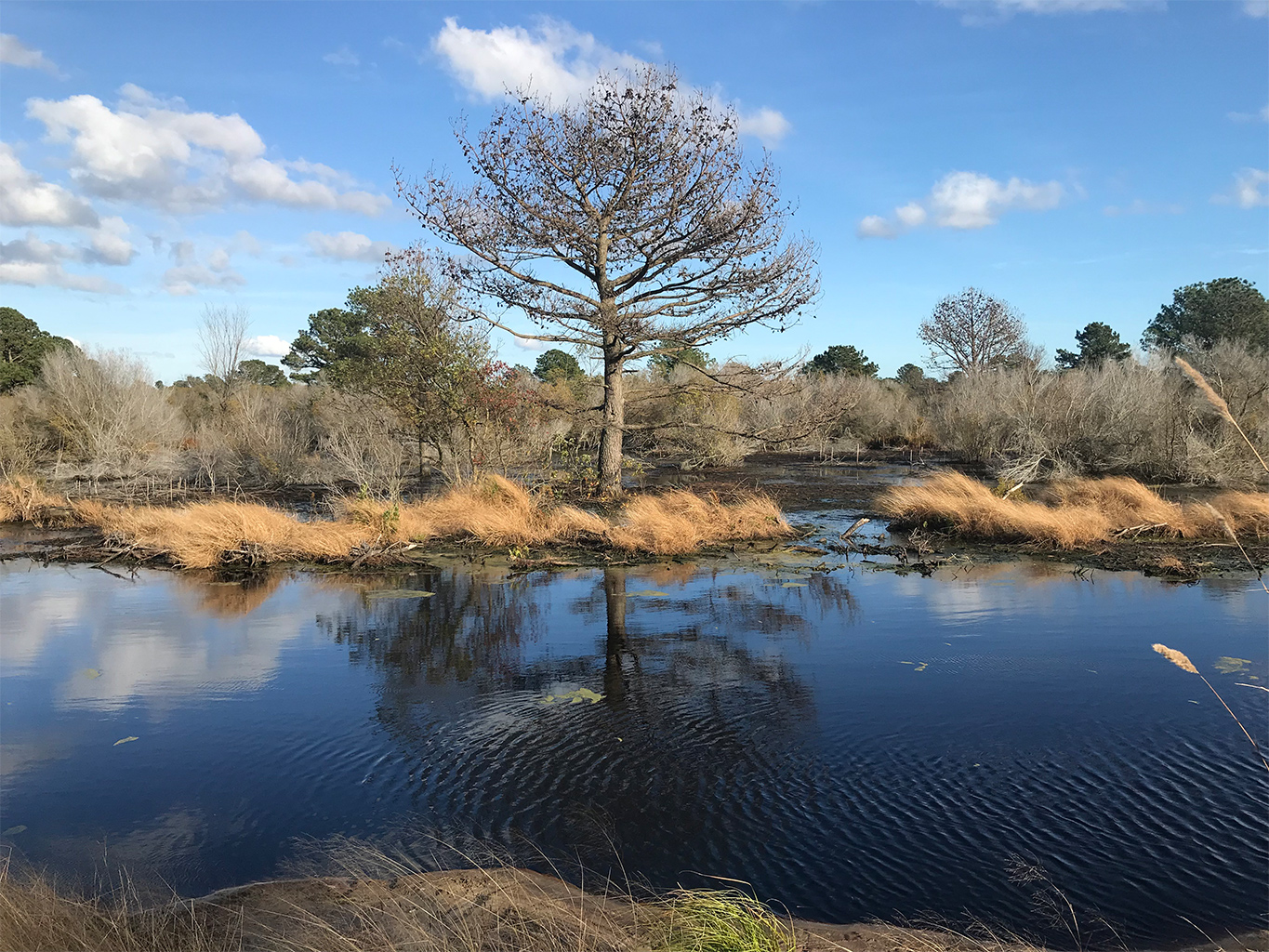

Bringing back the swamp on a gradual hill
“It’s really three components,” says Howard Phillips, as he describes the slow evolution of restoration at Pocosin Lakes National Wildlife Refuge (PLNWR), for which he was refuge manager from 2001 until 2020, when he retired. “You got to understand what was there to begin with, how it was altered, and then how we are trying to reverse that alteration.” What’s been done here could serve as a model for temperate peatland restorations the world over.
For thousands of years before Columbus arrived in America, the pocosin peat landscape was built up layer by layer as vegetation grew, died and subsided back into the waterlogged environment. There it never fully decomposed, and hence it captured and held the long-dead organic material’s carbon. The ground became spongy, even buoyant, due to the water-soaked soils underneath, and the region became home to unique peatland-habituated animal and plant species. Today’s PLNWR protects one of the world’s only surviving wild populations of red wolf (Canis rufus).
The North Carolina peatlands were vastly altered by European arrivals. First, the colonizers logged the landscape. Then in the 1840s, they forced slaves to try to drain the ecosystem’s Pungo Lake, a failed effort.
Later, local farmers built a complicated (what Phillips calls an “ingenious”) canal network to drain the swamp on a hill. The farmers took advantage of the peatland’s very, very gradual slope — just 6 feet of elevation gained over 6 miles, like putting a dime under one end of a 20-foot-long plank, Phillips says — to make it suitable for crops and livestock. Eventually their canal and ditch system drained 40,000 acres (16,200 hectares).
The settlers, of course, had no idea they were unleashing a carbon monster.
To “reverse the alteration,” Phillips led his PLNWR staff in a 19-year effort to construct an equally ingenious hydrologic system to bring water back into the swamp on a hill at levels mimicking the natural system.
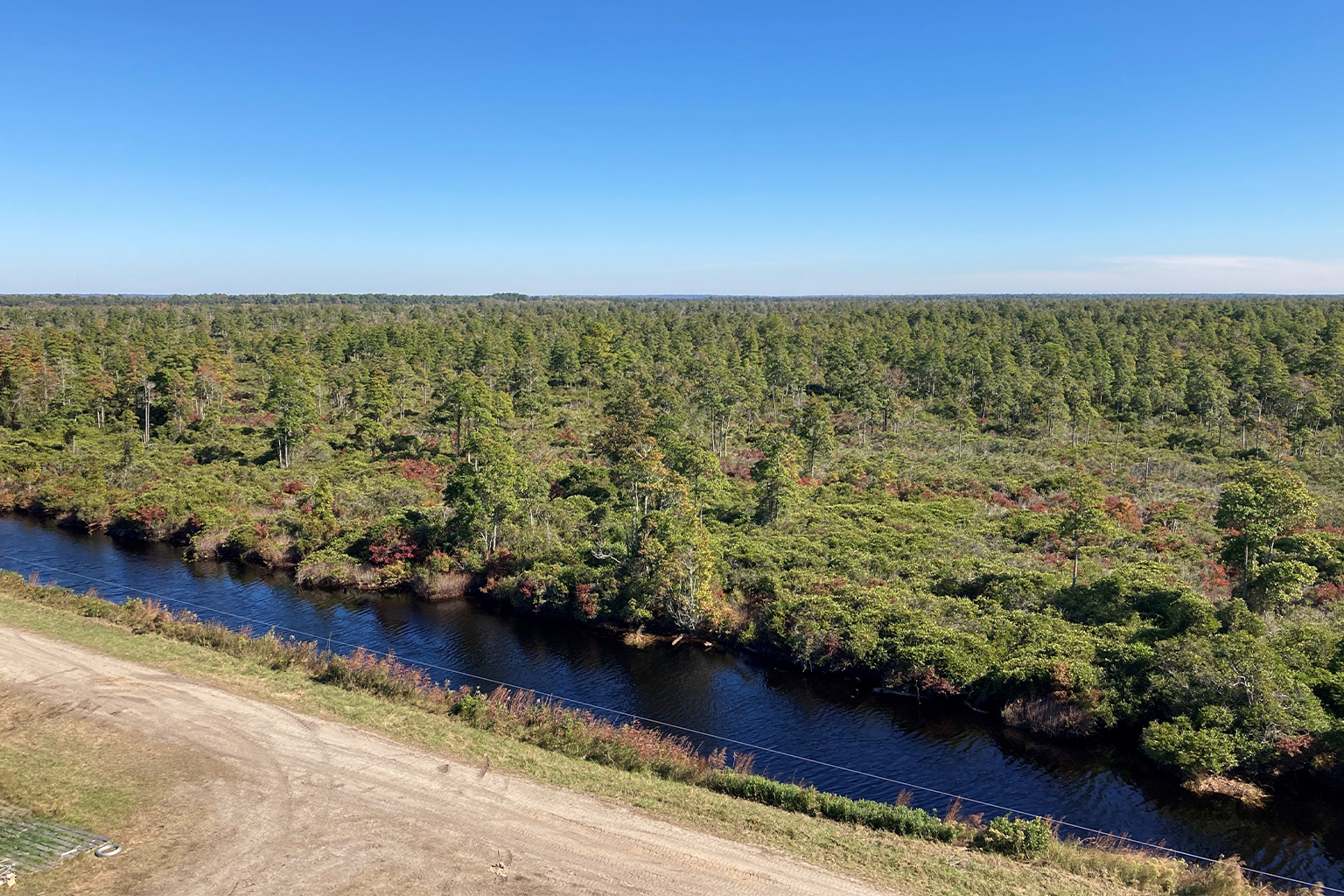
Phillips, who remains a regional representative of the nonprofit National Wildlife Refuge Association, says the simplest solution — blocking all the old canals — couldn’t be done because it would have flooded the lands of adjacent property owners.
“And we can’t do that kind of thing.” Instead, he said, “We came up with a plan that would mimic the natural hydrologic conditions that you find in the pocosin as closely as possible in that highly altered system.”
Phillips’s team installed flashboard risers in the existing canals to allow for better water level management. Commonly used for irrigation, flashboard risers are culverts where wooden boards can be inserted to dam the water at varying desired levels.
“Then we figured out what board elevation would correspond to a water elevation out across the landscape,” Phillips explains, comparing the process to terrace farming. “Basically … you’re stopping the water from going down too low … We’re just stepping that [lost] water back up that hill, all the way to the top.” The landscape restorers found that the very top of the pocosin could be wettened quite easily by simply plugging the drains.
“It was probably the closest thing to a naturally functioning pocosin that we had in the crop areas. It was pretty cool,” Phillips says with pride. The work, begun in the 1990s, took decades, not because it required that much time, but due to inconsistent funding.
“We would get a little bit of money, and do a little bit of the work. And then we get a little money the next year and we do some more … It took us a long time to get the funding put together, right?” Phillips recalls. “If you were doing it now, with [the urgency placed on] climate change … you could probably get the thing funded and do it all at one time.”
Restoration continues today at Pocosin Lakes. Some areas have been thoroughly restored and entered a management phase, but Wendy Stanton, the current manager of Pocosin Lakes, says there are still more than 10,000 acres of peatland that need restoration.





Restoring Scotland’s Flow Country
None of the world’s temperate peatlands are exactly alike. And no restoration project looks the same, though lessons can be drawn from each.
About 4,000 miles (6,400 kilometers) from North Carolina’s pocosins is the Flow Country of northern Scotland. Currently in the running for World Heritage Site status, the Flow Country is 1,500 square miles (3,900 square kilometers) of peatland and wetlands, considered the largest blanket bog in Europe (a bog being defined as a peatland fed primarily by rainfall, not groundwater).
Unlike much of the peatlands in England, Ireland and the rest of Scotland, the Flow Country hadn’t been widely disturbed by agriculture, or by turf cutting and mining for horticultural peat. It remained relatively undisturbed until the 1980s.
“There was relatively little interest in peatlands,” and they were undervalued in the U.K. then, which paradoxically led to a disastrous government decision, explains Richard Lindsay, head of environmental and conservation research at the Sustainability Research Institute of the University of East London.
“In the 1980s a government tax system called the Forestry Grant Scheme was exploited by super-tax earners, such as the [rock ’n’ roll] band Genesis, to plant huge areas of cheap land purely for tax reasons,” says Lindsay.
And cheap land, of course, meant property historically thought of as wasteland: The tax avoiders turned their attention to peatland because it was the least expensive property on the market. “No one could do anything financially worthwhile with it,” says Lindsay, and within a matter of years wealthy Britons planted 190,000 hectares (470,000 acres) of peatland with trees, including 67,000 hectares (166,000 acres) in the Flow Country. And as Lindsay points out, “The trees,” many of them non-native and ill-suited to the land, “did not have to survive to reap the tax benefits.”
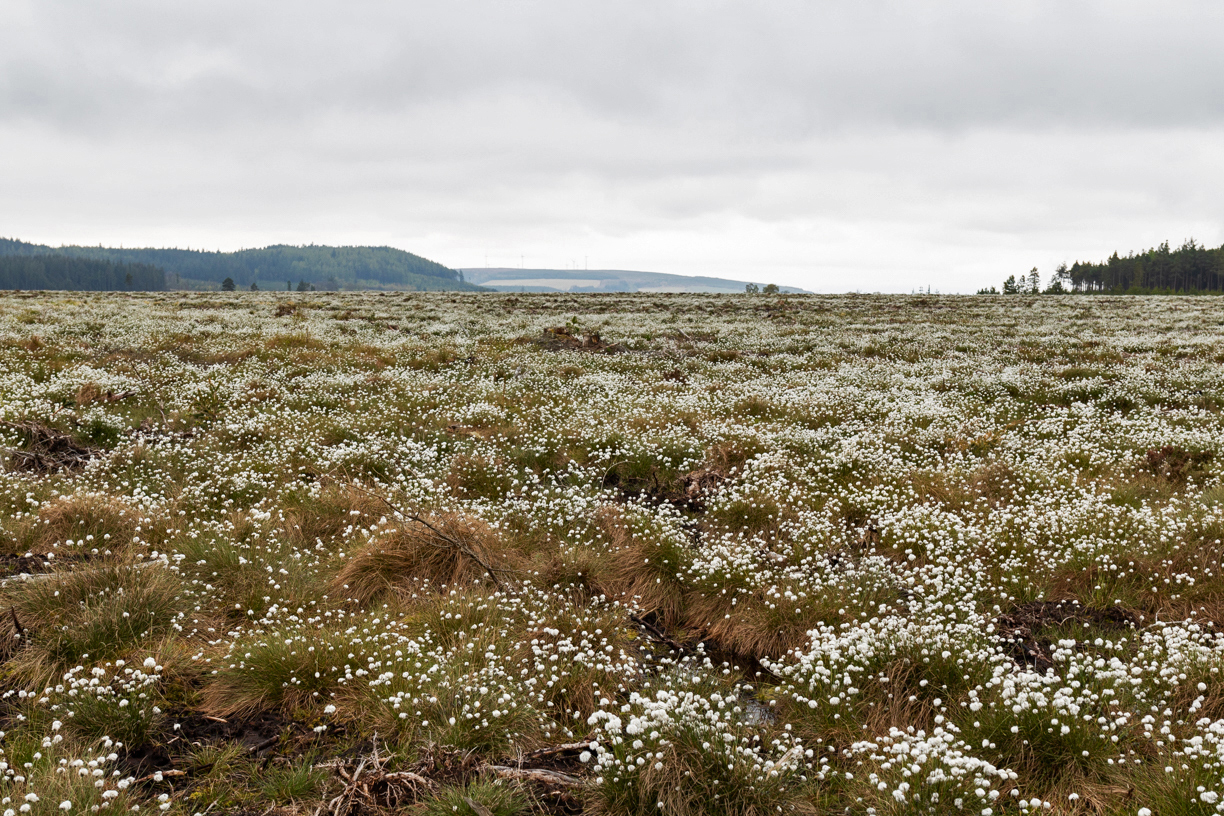

In order to plant these exotic conifers, mostly lodgepole pine (Pinus contorta) and Sitka spruce (Picea sitchensis), foresters first had to build ditches to drain and dry out the peatlands, thus degrading and destroying their true ecological and carbon storage value.
Eventually, scientists and activists, led by the Royal Society for the Protection of Birds (RSPB), lobbied the government to correct its mistake. In 1988, authorities moved to protect the non-forested portions of the Flow Country and repealed the tax break.
But this did nothing to reverse the damage already done to peatlands now planted with struggling alien trees. Change only came for these disturbed peatlands when the U.K. government woke to the vital role peatlands play in combating climate change.
In 2020, the Scottish government put 250 million pounds ($320 million) into peatland restoration, including the Flow Country, aiming to restore 250,000 hectares (618,000 acres) of peatland by 2030. This initiative came as part of Scotland’s commitment “to help reach net zero [carbon emissions] by 2030,” says Amanda Ophof, a national peatland adviser within the government department Forestry and Land Scotland.
With sufficient funding, peatland restoration began across the U.K. In the Flow Country, conifers were cut and either left to rot, mulched or removed. Drains were plugged, allowing the water table to recover. Finally, land managers began the challenging task of smoothing out land contours that had been plowed or furrowed to facilitate tree planting.
“We’ve learned that sometimes particular attention is needed to [topography] reprofiling to ensure the ridges start to transition back to functioning peatland,” said RSPB principal conservation scientist David Douglas.
Despite all this effort, conservationists admit that Scotland has a long way to go before the Flow Country, and the nation’s other peatlands, are fully restored. More than 60,000 hectares (148,000 acres) of the Flow Country alone remain unnaturally forested today.


Restoring Canada’s oil sands
Few countries can beat Canada for peat. It has some of the largest extant and undisturbed peatlands on Earth, boasting more than 1.2 million km2 (463,000 mi2) — an area about the size of South Africa.
The good news is that in Canada, “The extent of damaged peatlands is a much smaller percentage of land area than in most countries,” says Jonathan Price, a professor at the University of Waterloo in Ontario province.
Canada, too, has launched ambitious restoration projects, largely funded by the horticultural industry, a business that extracts peat for gardening purposes. “They’ve already restored 74% of their footprint,” says Line Rochefort, a professor with expertise on peatlands at Laval University in Quebec.
But perhaps best known are a scattering of peatland restoration projects launched in western Canada in an attempt to restore lands mined by the oil sands industry (also known as tar sands production), which extracts bitumen, or heavy crude oil, from forest lands, wetlands and peatlands.
Price says such projects are more “reclamation” than “restoration, since there is nothing left to ‘restore,’” after the fossil fuel industry finishes strip mining. Around half the area in the Athabasca Oil Sands in Alberta province is peatland, according to Price, notably fens. Fens are peatlands largely fed by groundwater, rather than rainwater.

“There have been just two pilot projects to test the concept” of oil sands reclamation back to peatland, says Price. He points to Nikanotee Fen, a 32-hectare (79-acre) wetland recreated by fossil fuel corporation Suncor. The other project, Sandhill Fen, covers 57 hectares (141 acres). To rebuild the lost ecosystems, Price says workers must reconstruct the wetland from scratch by constructing a flow system that moves groundwater discharge to a peat deposit taken from other stripped areas.
Price, who did the conceptual design for Nikanotee Fen, says the rebuilt fen is currently accumulating carbon and hosts many of the plant species consistent with this natural environment. “The water budget is strongly influenced by the designed groundwater flow system,” he says. “And it remains persistently wet [today] even under drier than normal conditions.”
He adds that sodium leaching from the mining’s tailings remains a detriment, but restorers believe that excess sodium will be flushed out of the ecosystem within 30 years of peatland reestablishment. Work on the Nikanotee Fen finished in 2012.
“The goal for the Nikanotee Fen was to establish a carbon accumulating peatland with a representative mix of plant species, that is resilient to projected stressors, including climate change,” Price explains. “An important challenge is to optimize the construction to reduce costs.”
By law, oil sands mining corporations in Alberta must return the landscape to some equivalent of what was lost. Unfortunately, notes Price, “there have been no new attempts,” at reclaiming peatlands from oil sands operations since the work on Nikanotee and Sandhill, due to the costs of the pilot projects.
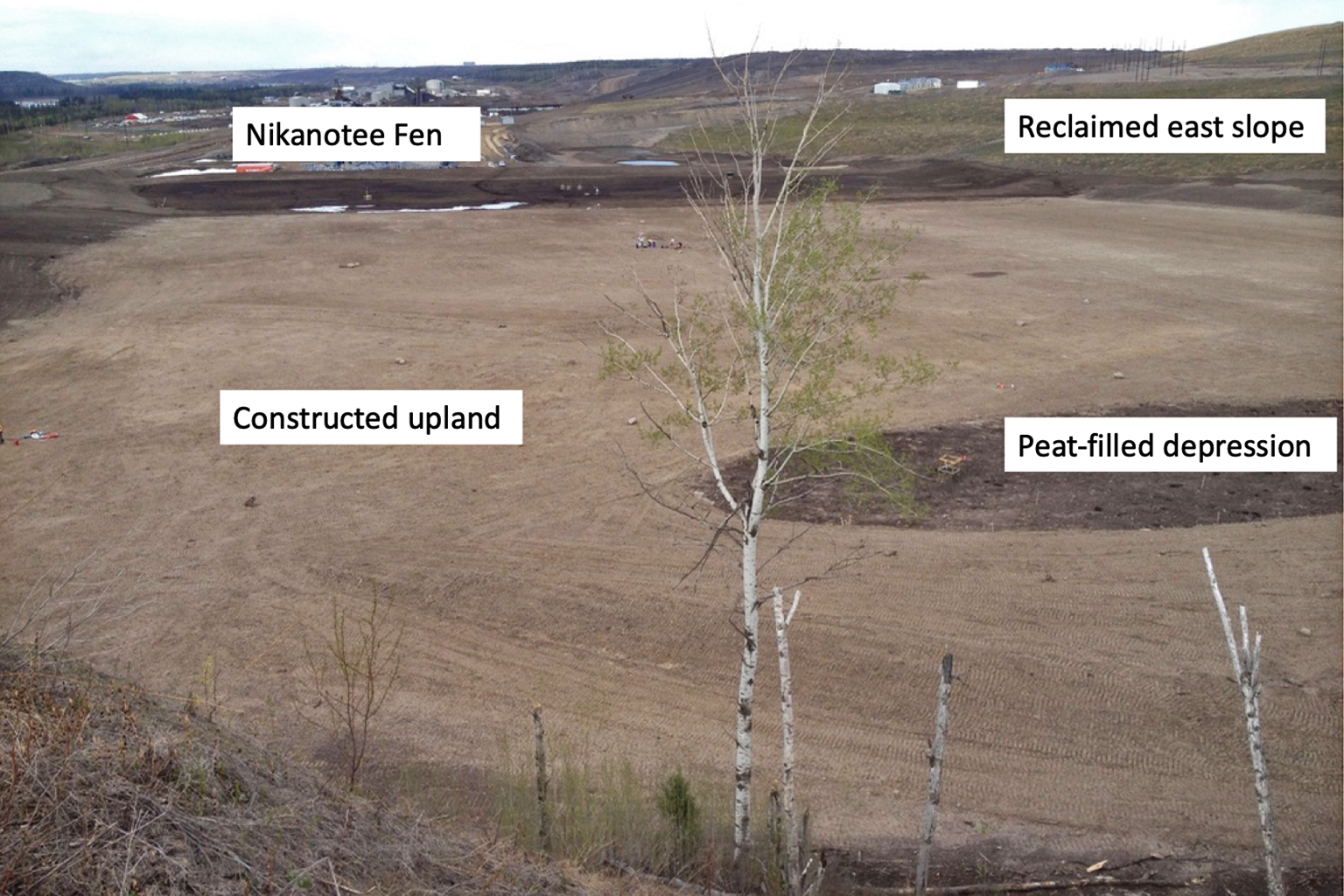

Climate change a growing peatland threat
All the positive news about peatland restoration is being tempered by experts’ awareness of an escalating problem: Climate change itself is endangering the world’s peatlands. They fear that escalating heat and drought could lead to intact peatlands drying out, turning carbon sinks into sources.
Disturbed peatlands are the most vulnerable to our hotter world. “Peatlands in a degraded condition experience more erratic water table fluctuations throughout the seasons, decreased ability to hold onto water within the peat,” says Scotland government adviser Ophof. “This will cause further peat oxidization” of dead vegetation, leading to more carbon emissions.
But restoration continues being a way to fight this problem: “In a warming world the priority is to restore degraded areas as quickly as possible,” says Scottish scientist Douglas. And the race is on: He points out that, even once restored, peatlands require several decades before they turn from carbon source back to sink.
Importantly, wet, healthy peatlands may be one of the most resilient ecosystems in the world to climate change stress, according to English researcher Lindsay. He offers core samples of ancient peatlands as evidence, demonstrating how these ecosystems have weathered past climate extremes.
“What we find is that peatlands have been remarkably resilient, steadily laying down peat over thousands of years and through many climatic shifts,” he says. “They can do so by altering their peat-forming vegetation composition from one suited to very wet conditions, to one suited to drier conditions, and vice versa, through a series of elegant yet robust feedback systems.”
Price notes that some peatland types will likely be more resilient than others, with survivability depending on local conditions. Bogs, because they’re fed by rain and snowfall, may be particularly vulnerable to extreme drought. But “those in more humid areas could continue to exist as bogs in the event of a drier climate,” he says, while “those that exist in more marginal climates may dry out to an extent that impairs their function.”
Fens, which depend on groundwater, on the other hand, may only see shifts in their local plant communities as climate change worsens. If they lose enough groundwater, however, they could transition from fen into swamp.
The best natural buffer against climate change? Restore damaged peatlands now, and do it fast, say the experts.
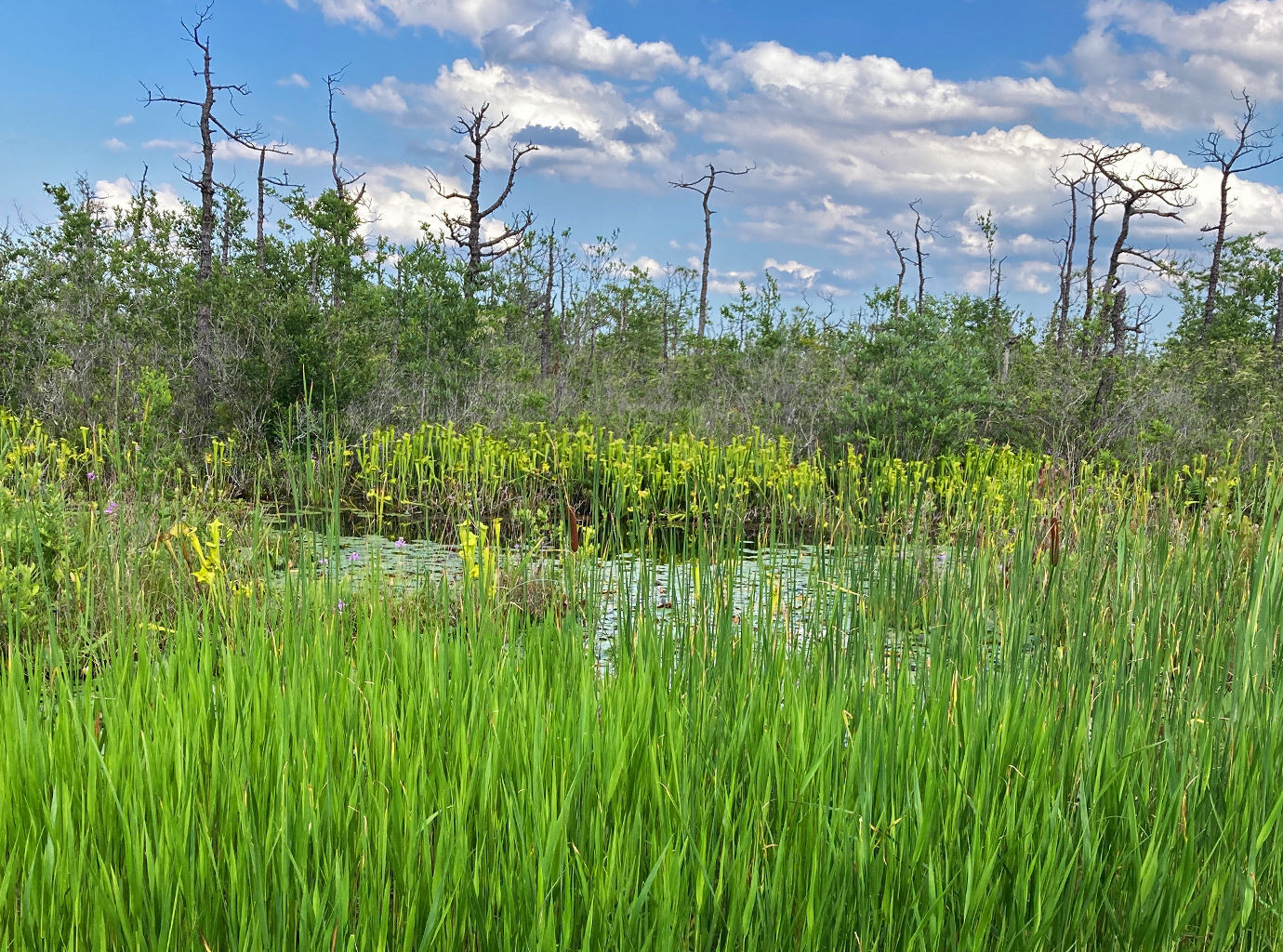
Evans Road Fire
On June 1, 2008, a lightning strike ignited another fire in the Pocosin Lakes National Wildlife Refuge. This blaze, known as the Evans Road Fire, didn’t burn for two weeks — but for months.
“When it gets that big and that bad, your only option is to flood it,” said Cabe Speary, fire environment forester with the North Carolina Forest Service. PLNWR officials and firefighters transported billions of tons of water from nearby lakes and canals to extinguish the ground fire, which spread smoke and air pollution across the region.
The final flames weren’t put out for seven months; 42,000 acres (17,000 hectares) burned. The summer fire hit during the worst drought on record in North Carolina, highlighting the link between climate change’s extreme weather events and the threat to peat ecosystems.
That was “about six to eight months of my life I’ll never get back,” remembers Howard Phillips, who was the refuge’s manager at the time. But he believes PLNWR, after decades of restoration, is better equipped today for such threats.
“You restore this hydrology … you’re not going to get as big a fire, not as intense, not as long duration. You’re going to be able to contain it or get it put out faster,” says Phillips. He notes, too, that an ounce of prevention is worth a pound of cure: The 1985 Allen Road Fire cost around $19 million to manage, while Phillips estimates he only spent around $1.5 million on restoration of the refuge’s pocosins over nearly 20 years.

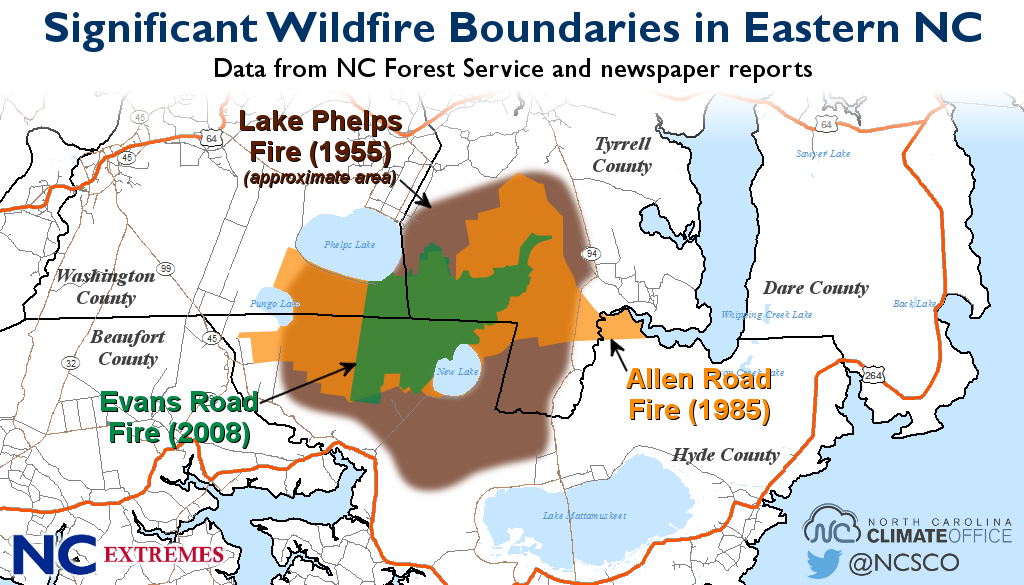
“That’s a really good return on your investment, if you could just avoid one of those big fires, just one. And I think we probably did,” Phillips adds. “It’s hard to prove the negative but we had [serious fire] conditions a couple of times [without fires] since 2008.”
Phillips says the water levels in the pocosins still dip during dry spells, but not as much as they did when the area was drained.
The same thing was found in Scotland: In May 2019, fire erupted in the Flow Country. It spread easily across the landscape that had been forested, but slowed when it hit the recently restored peatlands, according to Ophof.
“The rewetted peatland was covered by cotton grasses, indicating a high water table, making it less favorable for the fire to spread,” says Ophof. That’s another very good reason to restore peatlands: They can act as natural firebreaks in an age of climate change-intensified fires.
Phillips emphasizes the need for more restoration in the PLNWR, and he hopes the government provides the funding for it. The refuge’s peatland restoration “has not gotten the notoriety that I believe it should have,” he says. “And it’s because we didn’t go in and try to get all of the money at once. We just kept working on it and working on it.”
Banner image: A black bear stands onshore looking at four tundra swans on the water at the Pocosin Lakes National Wildlife Refuge. Image by Beverly Meekins/FWS.
Related audio from Mongabay’s podcast: For a view on peatlands restoration in Indonesia, here’s a conversation with the Deputy Head of the National Peatland Restoration Agency, Budi Wardhana, and with Dyah Puspitaloka, a researcher at CIFOR , listen here:
Scientists plead for protection of peatlands, the world’s carbon capsules
FEEDBACK: Use this form to send a message to the author of this post. If you want to post a public comment, you can do that at the bottom of the page.
